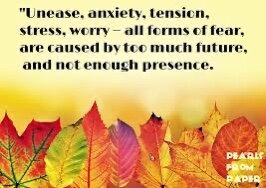The land of ‘what if’.
Do we wake up one morning and think to ourselves, ‘I feel stressed’. I don’t think so. Stress very rarely happens that way. Stressors accumulate over time, they are not the big life changing events like shifting home, pregnancy, getting married etc. Rather they are the seemingly little moments that impact us the most. The overflowing email inbox, the growing number of templates for planning that we have to fill in that we don’t find the time to do, the conversations that we need to have with colleagues that we just don’t seem to find the time for………
I try very hard to go for a walk every day. Walking for me is about taking the time to listen to nature and to think about my own internal voice. I have started to compile a book of photos with my reflections, the title of the book is, ‘Listen, Nature is Talking’. While out one morning heading to the beach I noticed a strange phenomenon. (illustrated below). A bus was parked waiting for its scheduled departure time and commuters were making their way to the bus stop. What I reflected on in this moment was the different ways commuters approached the waiting bus. There were two groups one group were running frantically for the bus, the second group were unrushed, enjoying the walk and companionship.
Why did this moment grab my attention? It was the absolute extreme between the two responses to starting the day. One group I imagine are living with cumulative stress and possibly don’t even realise some of the factors that are contributing to this. While the other I can imagine living in the now.
We all want to live a less-stress lifestyle. One of the steps to doing this is to live in the now. I am sure you will recognise these words, ‘what if’. When we live in the land of ‘what if’ we can see problems everywhere. Have you noticed how, when you focus on your problems, they continue to multiply? Although most of the ‘what if’ gremlins are made up by us, they surround us and cause us bags of stress. We end up living on an unrealistic planet, the world of ‘what if’.
What does the world of ‘what if’ look like in ECE? What if we can’t articulate what we do, what if there is not enough time to get all the things I want to do done, what if I can’t get that learning story written, that form filled out, what if ERO can’t see what we are doing, what if we never get to have that important conversation about teaching and learning, mainly WHAT IF THERE ISN’T ENOUGH TIME. The fear of ‘what if’ robs kaiako of their joy.
I have visited many centres over the last month and have been disheartened by the amount of planning that is required. There seems to be so many layers of planning that it is sucking the joy and passion out of what kaiako are doing. This is incredibly sad and it must create stressors for kaiako as they struggle to keep their heads above water with the amount of paper work they think IS expected. The struggle with paper work I think has come from the land of ‘what if’.
How did we get to this place????????
The land of ‘WHAT IF’ has created fear and uncertainty in ECE. The fear and uncertainty has lead to an overload of forms, papers and accountability measures that do not connect to the mokopuna and the passion of the kaiako. If you feel like you are weighed down with assessment, planning, evaluation and professional growth cycle then possibly you have made decisions based on ‘what if’ rather than what connects with your heart and passion. The Planning Dance talks about assessment of learning that reflects the intent of Te Whāriki. As kaiako we are making decisions moment by moment in response to the mokopuna, this is planning, which is written up retrospectively using the Learning Outcomes to help us assess learning.
There has been a subtle but very impactful shift in ECE, we have moved the Learning Outcomes to the front-frame because, ‘what if’ ERO cannot see the Learning Outcomes inside our Curriculum Design. The shift has led to IDP writing, evaluating the learning of the mokopuna and a whole lot more paper work for kaiako. The problem is that we are now living in the land of ‘what if’ and it is creating a lot of stressors for the kaiako.
How can we move into the land of ‘letting go’. Letting go of the fear, where we have the time to be truly present with mokopuna, kaiako and whānau. Simple…. we go back to what we were doing, writing robust learning stories that use the notice, recognise and respond format that can be used for curriculum design, evidence for internal evaluation and professional growth cycles. Start trusting ourselves that we are doing what Te Whāriki ask us to do, “Kaiako in ECE settings weave together the principles and strands, in collaboration with children, parents, whānau and communities,
to create a local curriculum for their setting. Understood in this way, the curriculum or whāriki is a ‘mat for all to stand on.”



